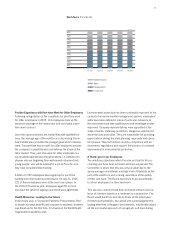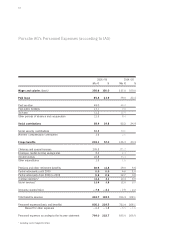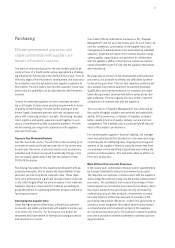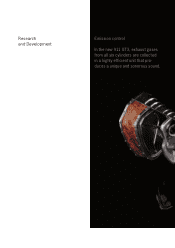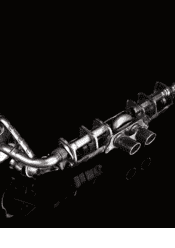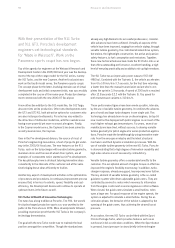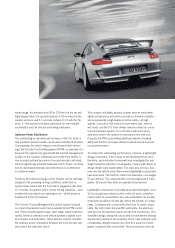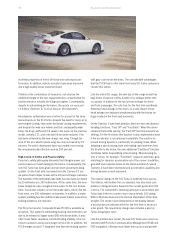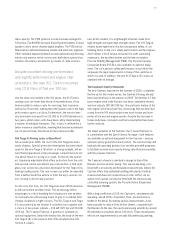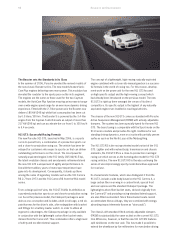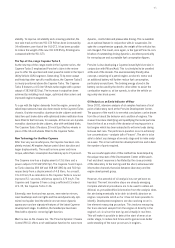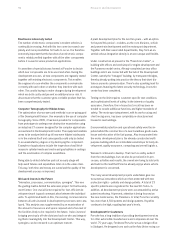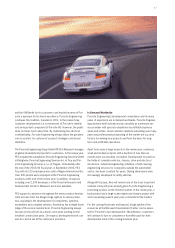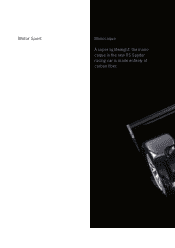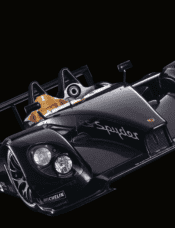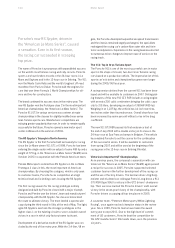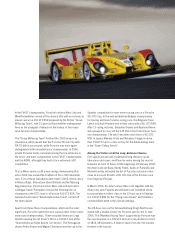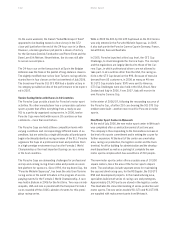Porsche 2005 Annual Report Download - page 97
Download and view the complete annual report
Please find page 97 of the 2005 Porsche annual report below. You can navigate through the pages in the report by either clicking on the pages listed below, or by using the keyword search tool below to find specific information within the annual report.95
stability. To improve roll stability and cornering potential, the
rear axle track on the new 911GT3 RS has been increased by
34 millimeters over that of the 911 GT3. It has been possible
to reduce the weight of the new 911GT3 RS by 20 kilograms
compared with the 911GT3.
The Top-of-the-range Cayenne Turbo S
As the new top-of-the-range model in the Cayenne series, the
Cayenne Turbo S emphasized Porsche’s claim in the review
year to offer the sportiest and most powerful model in the Sport
Utility Vehicle (SUV) segment. Generating 71 hp more output
and featuring other specific modifications, the Cayenne Turbo S
is clearly positioned above the Cayenne Turbo. The Cayenne
Turbo S features a 4.5-liter V8 twin-turbo engine with a power
output of 383 kW (521 hp). The increase in output has been
achieved by installing much larger, optimized intercoolers and
improved engine management.
To cope with the higher demands from the engine, several de-
tailed improvements have also been made to the Cayenne Turbo
chassis. 6-piston monobloc aluminum brake calipers and venti-
lated two-part brake disks with optimized brake ventilation have
been fitted to the front axle, for example. At the rear are 4-piston
monobloc aluminum brake calipers, also with ventilated disks.
The Cayenne Turbo S features 20-inch SportTechno wheels in
place of the 18-inch wheels fitted to the Cayenne Turbo.
New Technology for the New Cayenne
After four very successful years, the Cayenne has been com-
pletely revised. All engines feature petrol direct injection and
larger displacements. The result is more power and more
torque, whilst fuel consumption has fallen by up to 15 percent.
The Cayenne now has a displacement of 3.6 liters and a
power output of 213 kW (290 hp). The Cayenne S and Cayen-
ne Turbo develop 283 kW and 368 kW (385 hp and 500 hp)
respectively from a displacement of 4.8 liters. As a result,
0 to 100 km/h acceleration in the Cayenne Turbo is now an
improved 5.1 seconds, whilst top speed is 275 km/h. The
Cayenne and Cayenne S have a drag coefficient (Cd value)
of 0.35, the Cayenne Turbo 0.36.
Externally, new front and rear aprons, new exterior mirrors,
main headlamps and rear lights and the aerodynamically opti-
mized roof spoiler lend the vehicle an even more dynamic
appearance and are signature features of the latest Cayenne
development stage. In addition, the headlamps have been
fitted with a dynamic cornering light function.
Much is new on the chassis too. The Porsche Dynamic Chassis
Control (PDCC) offers a roll stabilization function for even more
dynamic, comfortable and pleasurable driving. This is available
as an optional feature in conjunction with air suspension. De-
spite the comprehensive upgrade, the weight of the vehicles has
not changed. The result, once again, is the typical Porsche com-
bination of outstanding driving dynamics, excellent practicality
for everyday use and acceptable fuel consumption figures.
Porsche is also developing a Cayenne-based hybrid version in
conjunction with VW and Audi. This is scheduled to be unveiled
at the end of the decade. The environmentally-friendly drive
concept, consisting of a petrol engine, an electric motor and
an additional battery will further reduce fuel consumption,
particularly around town. The braking energy stored in the
battery can be used by the electric drive either to assist the
combustion engine or, at low speeds, to drive the vehicle us-
ing solely electrical power.
Oil Analysis as an Early Indicator of Wear
Since 2002, intensive analysis of oil samples has been a focal
point of laboratory work at the Porsche Development Center.
The purpose of the work is to see what conclusions can be drawn
from the oil about the behavior and condition of engines. The
research involves identifying and quantifying the metal particles
found in the oil as a result of the abrasion of moving parts in a
test engine which has been subjected to extreme loads during
in-house test runs. The particles in question occur in extremely
low concentrations – analysts talk of “traces”. The aim is to be
able to detect any damage at an early stage and to make analy-
sis easier. This in turn will shorten development time and reduce
the number of parts required.
The successful application of this method has been helped by
the unique structure of the Development Center at Weissach.
Fast and direct response is facilitated by the close proximity
of the laboratory to the test rigs and the short, unbureaucratic
information channels that exist between laboratory and the
engine development group.
However, the potential of oil analysis has not yet been ex-
hausted. The next innovative steps are already emerging.
Complex statistical procedures are to be used to obtain ad-
ditional, as yet unidentified information from the analysis data,
the aim being eventually to be able to identify abrasion on
engine components which so far it has not been possible to
identify. Development engineers are also working on an in-
line element measuring procedure. This involves measuring
the trace element sample from the engine oil directly in the
engine’s oil circuit on the test rig and virtually in real time.
This will make it possible to detect the start of wear at an
earlier stage, to reduce test times and to gain an even better
understanding of the wear processes in engines.


